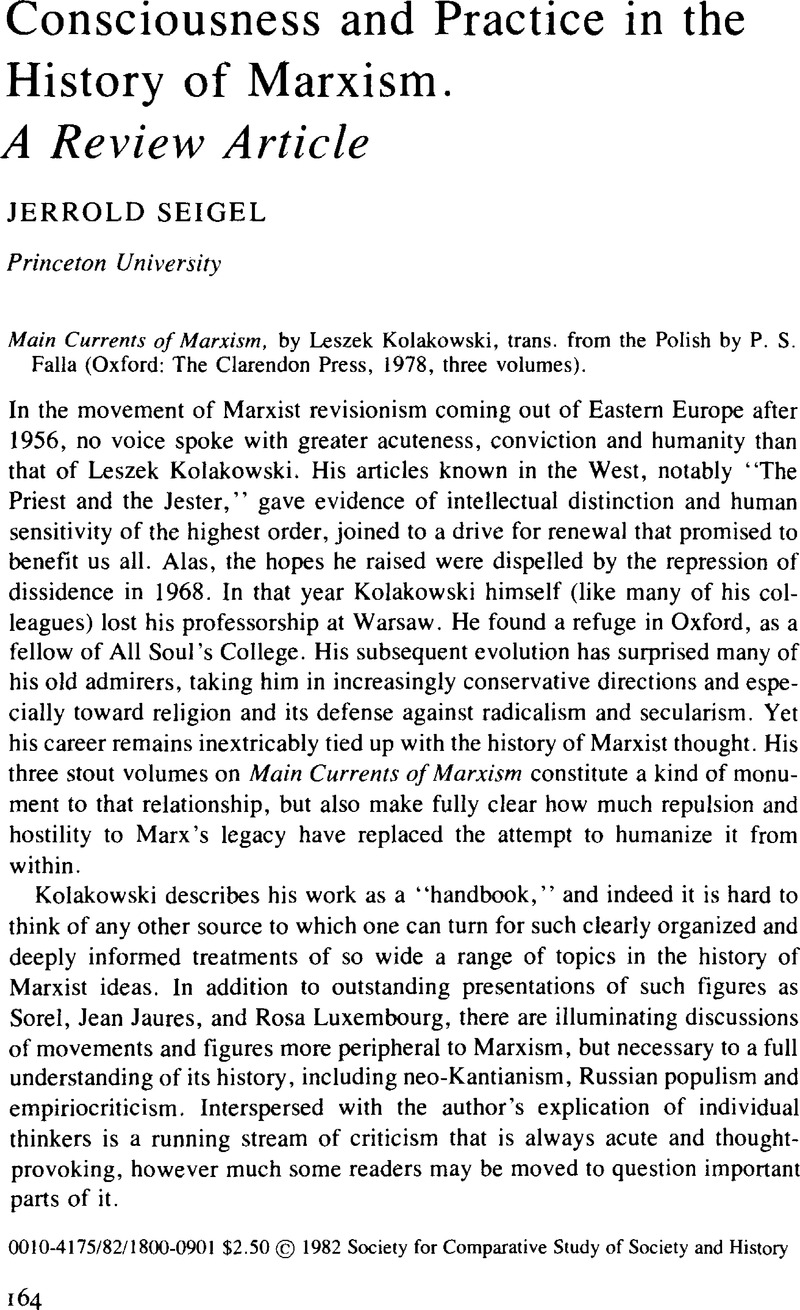No CrossRef data available.
Article contents
Consciousness and Practice in the History of Marxism
Published online by Cambridge University Press: 03 June 2009
Abstract

- Type
- The Human Nature of Materialism
- Information
- Copyright
- Copyright © Society for the Comparative Study of Society and History 1982
References
1 Citations in parenthesis refer to volume and and page in Kolakowski's work.
2 It is true that Kolakowski prefaces his treatment of Russian Marxism with an account of the “special political and economic circumstances” historians have adduced to account for its “peculiarities,” thereby seeming to suggest that historical circumstances led Russian Marxists, including Lenin, to alter Marxism. But we know that this is not in fact his view, Leninism, at least as interpreted by Lukacs, being an essentially correct version of Marx's dialectic. Just what importance Kolakowski attributes to the historical circumstances out of which Leninism arose is not clear. Logically they play no necessary role in his account, since Leninism was not a matter of “peculiarities” but rather a recovery of the genuine content of Marxism that had been lost before. The most we get on this score is a statement that, although there “is no doubt much truth” in the explanations based on historical circumstances, “they do not suffice to account for the spread of Russian Marxism in its Leninist form in other parts of the world after the October Revolution” (II, 305).
3 This is at best an odd observation, since as Kolakowski knows, many real and important currents in Western Marxism have rejected the Soviet model in Gramscian terms. Odder still is the fact that Kolakowski offers this criticism after having called Gramsci to order for seeming to suggest that “the rightnessof an idea is confirmed by, or perhaps actually consists in, the fact that it prevails historically—a view irreconcilable with the usual one that truth is truth no matter whether or when it is known, or who regards it as true” (III, 229).
4 I cite Marx's text from Writings of the Young Marx on Philosophy and Society, trans, anded. by Easton, Lloyd D. and Guddat, Kurt H. (New York, 1967), pp. 263–64 (Marx's italics).Google Scholar
5 For an extensive justification of this periodization see my account in Marx's Fate: The Shape of a Life (Princeton, 1978).Google Scholar
6 Marx, Karl and Engels, Frederick, The German Ideology, ed. by Ryazanskaya, S. (London, 1965; Moscow, 1968), pp. 38 and 259.Google Scholar
7 Ibid., pp. 85–87.
8 Kolakowski's focus on Marx's “philosophical anthropology” leads him to neglect this aspect of Mar's early thinking both in regard to his attraction to Feuerbach and his subsequent criticism of him. Particularly objectionable is Kolakowski's treatment of “alienation” in The German Ideology. He totally fails to recognize Marx's criticism of that notion and of the attempt to construct a theory of human history in terms of it. The fact that Marx returned to alienation theory himself later on, in the Grundrisse and Capital is no excuse for Kolakowski's failure to inform his readers that in 1845 Marx described it as an abstraction that allowed philosophers to “transform all history into an evolutionary process of consciousness.” See The German Ideology, p. 86Google Scholar, and Writings of the Young Marx, p. 468.Google Scholar
9 Marx's Introduction was first published in English as an appendix to the Contribution to a Critique of Political Economy, trans, by Stone, I. (Chicago, 1904), p. 101Google Scholar; cf. Grundrisse, trans, by Nicolaus, Martin (London, 1973), p. 101.Google Scholar
10 In the book cited above, note 5.




